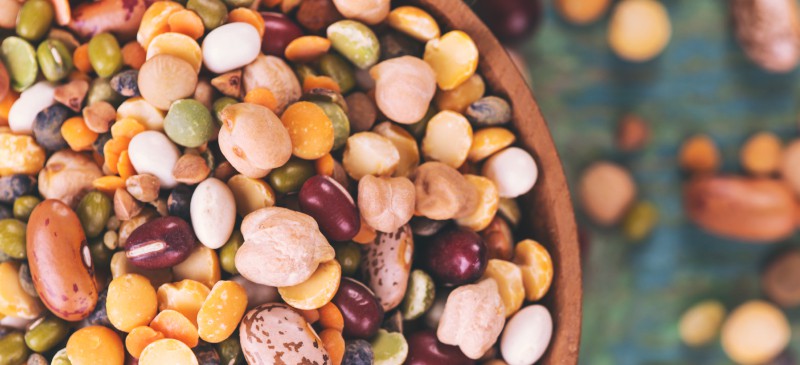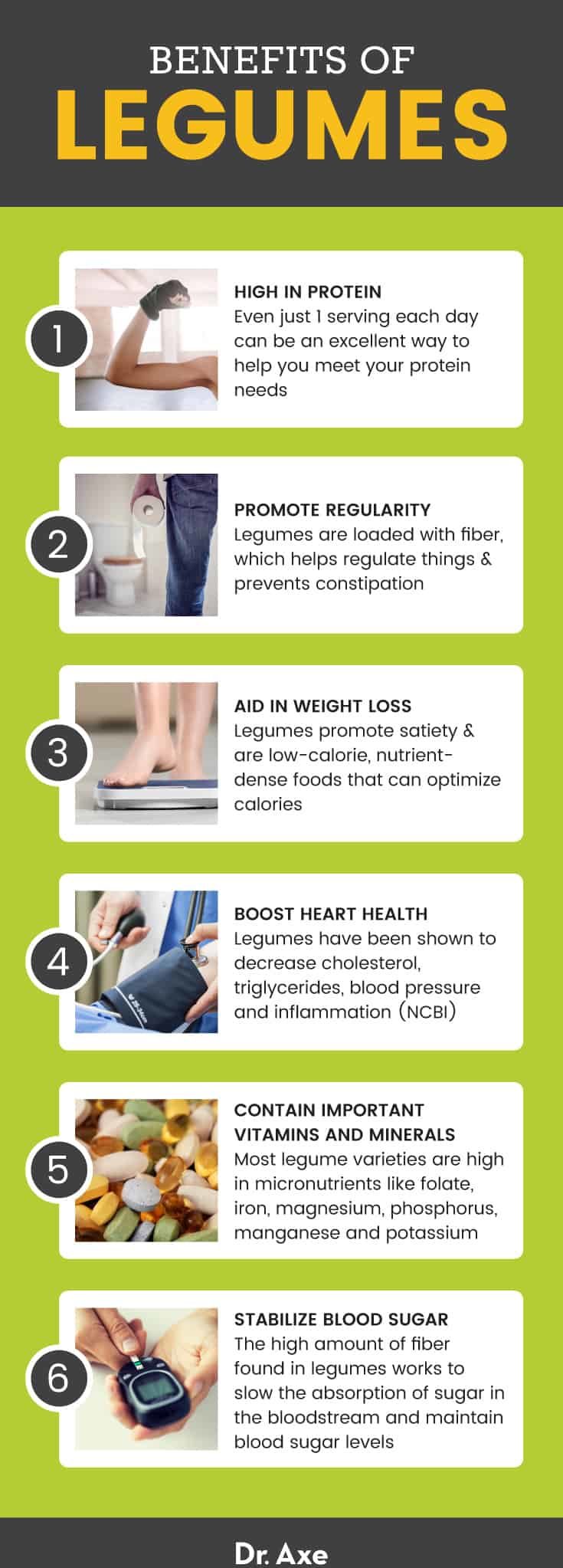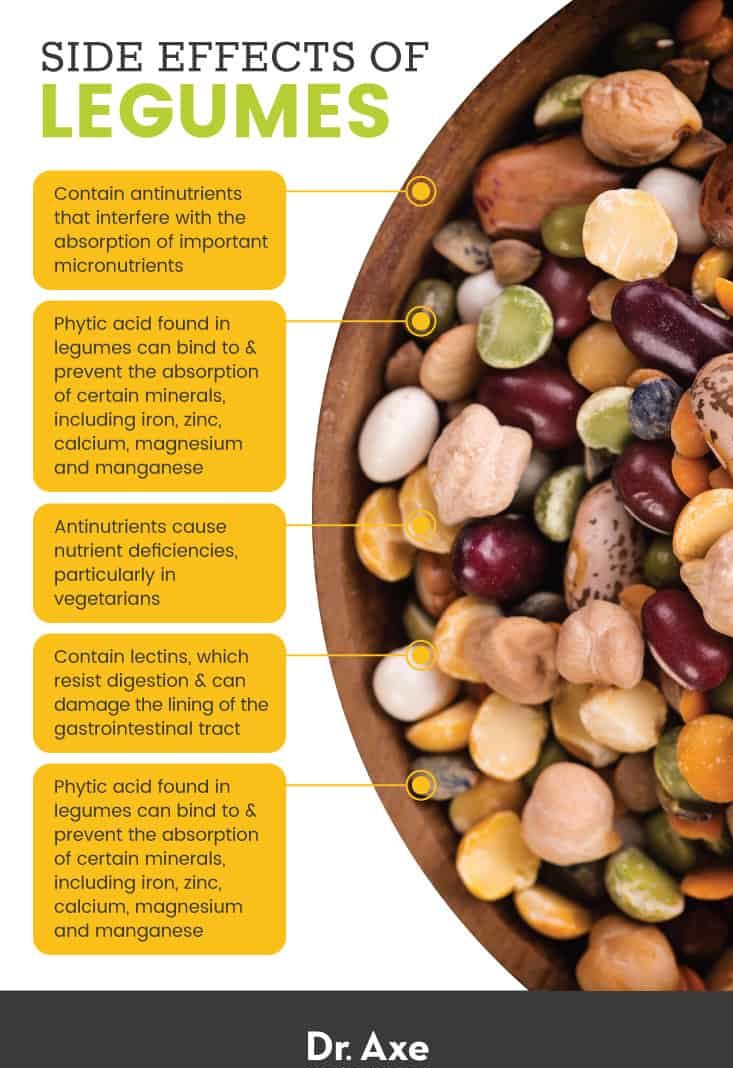
There’s a good chance you’ve heard of them and an even better chance you’ve had them on your plate at some point. But exactly what are legumes?
These “seeds” are packed in fiber and protein, plus an array of vitamins and minerals, particularly the best legumes to eat. They’re low in calories and a staple in vegetarian diets and vegan diets worldwide.
Despite their high nutrient content, legumes have been laden with controversy because they also contain compounds called antinutrients, which interfere with nutrient absorption. Luckily, there are methods that can be used to minimize the effects of these antinutrients, allowing you to reap the full benefits and nutrition of these versatile foods.
What Are Legumes?
According to Merriam-Webster, legumes are defined as “the fruit or seed of plants of the legume family (such as peas or beans) used for food.”
This food group encompasses the fruit or seed of any plant in the family called Fabaceae. This makes it a little tricky to define exactly what are legumes, as this family of plants includes a whopping 19,500 different species!
What are some examples of legumes? Though there are thousands of different types in existence, some of the most common varieties you’ll find in grocery stores include:
Note that peanuts are the only variety of “nut” included on this list. This is because, unlike other types of nuts, peanuts grow underground and belong to the Fabaceae family of plants.
They are technically not nuts at all, although they are normally thought of in this way.
Legumes have long been a dietary staple in many cultures, with some evidence showing that they began rapidly diversifying to form different species as many as 2 million to 4 million years ago in the Andes Mountains.
Still today, beans and legumes are essential dietary components around the globe. From South America to Asia and beyond, millions of people rely on the affordability, convenience and nutritional density of these foods each and every day.
What is the difference between beans and legumes?
Beans belong to the larger legume plant family. Not all legumes are beans, but all beans are considered legumes.
Beans are the seeds of several different plant varieties, including Phaseolus vulgaris (black bean), Glycine max (soybean) and Vigna angularis (adzuki bean). All of these plants belong to the Fabaceae family.
Nutrition Facts
What are three types of legumes? Beans, lentils and peas are the main classes of legumes and are all relatively comparable when it comes to their nutrition content.
Besides being rich in both protein and fiber, legumes are chock-full of vitamins and minerals as well. Most legume varieties are high in micronutrients like folate, iron, magnesium, phosphorus, manganese and potassium.
Some also contain a good deal of copper, zinc, calcium, B vitamins and selenium.
A cup of lentils, for example, provides 90 percent of your daily folate needs and 37 percent of the iron you need in a day.
Certain beans are also good sources of antioxidants. For example, black beans, red beans, pinto beans and kidney beans all contain anthocyanins, the same compounds found in deeply colored foods like berries, red cabbage, red wine and eggplant.
For this reason, legumes are an excellent way to round out a diet that may be lacking in certain nutrients. Vegetarians and vegans, for instance, may especially benefit from increasing legume intake to ensure that their needs for these important micronutrients are met.
Benefits
1. High in Protein
What are legumes good for? For starters, most contain a decent amount of amino acids and are considered some of the best sources of plant-based protein.
Chickpeas and navy beans, for example, each contain 15 grams of protein per one-cup serving, while white beans contain 19 grams of protein for the same amount.
Protein is considered a crucial part of the diet and critical to cellular function and muscle growth. For this reason, legumes become especially important in vegan and vegetarian diets and are often used as staple sources of protein.
When it comes to weight loss, eating enough protein can also encourage satiety and keep you feeling full while supporting a healthy metabolism and even increasing the amount of calories you burn after a meal.
Including even just one serving each day can be an excellent way to help you meet your protein needs.
2. Promote Regularity
In addition to their impressive protein content, legumes are high-fiber foods that can help promote healthy cholesterol levels and general cardiovascular health.
One cup of cooked lentils, for instance, contains 16 grams of fiber, or up to 64 percent of the daily recommended value.
When you eat fiber, it moves through your digestive tract slowly and adds bulk to stool to aid in its passage. This is especially beneficial when it comes to constipation.
In fact, increasing your fiber intake is one of the first lines of defense to help get things moving.
One analysis looked at five different studies and found that increased dietary fiber intake was able to significantly increase stool frequency in participants with constipation.
However, it’s important to keep in mind that you should increase fiber intake slowly and make sure to drink plenty of water as well. Sudden increases in fiber intake can cause unpleasant symptoms like gas, cramps or bloating.
3. Can Aid in Weight Loss
If you’re looking to shed some pounds, you might want to consider adding a few servings of legumes to your diet each week.
Not only are they high in filling fiber and protein, both of which can help promote satiety and ward off hunger, but legume consumption has also been associated with better weight management and prevention of obesity.
One study published in the Journal of the American College of Nutrition followed 1,475 participants over a span of eight years. Researchers found that those who ate beans regularly had a lower body weight, smaller waist size and a 22 percent lower risk of obesity.
Legumes are also very nutrient-dense foods, meaning they are low in calories but cram tons of vitamins, minerals and nutrients into each serving. This makes it easier to optimize the nutrients you’re taking in even when cutting your calorie intake.

4. Help Normalize Cholesterol Levels and Support Heart Health
It goes without saying that the heart is one of the most crucial organs in the body. It pumps out blood to all of the tissues in your body and supplies them with the oxygen and nutrients they need to function and thrive.
READ RELATED: 9 Sneaky Foods You May Not Realize Contain Caffeine
Paired with an otherwise healthy diet and active lifestyle, adding a serving or two of legumes to your plate each day can have a big impact on heart health. For example, many studies have demonstrated that a diet rich in beans and pulses can decrease both total and bad LDL cholesterol.
Several popular diets, including the DASH and Mediterranean-style plans, promote increased intake of plant-based foods such as beans and lentils due to their ability to improve glycemic control, blood pressure, cholesterol and body mass index.
One 2017 study published in the journal BioMed Research International found that eating legumes was associated with a decreased risk of heart disease. Other research indicates there are additional heart-healthy perks of eating legumes, such as decreasing triglycerides, blood pressure and inflammation.
According to a 2017 meta-analysis, beans may protect against heart disease in part because they are a substitute for unhealthy sources of protein, such as processed meats.
5. Help Stabilize Blood Sugar
Legumes are excellent at regulating your blood sugar and have been found in studies to significantly lower risks of heart disease, high blood pressure, stroke and type 2 diabetes. The high amount of fiber found in legumes works to slow the absorption of sugar in the bloodstream and maintain normal blood sugar levels and insulin sensitivity.
A 2014 study with over 2,000 participants found that blood sugar levels, among other factors, were lower in those who regularly ate legumes compared to those who didn’t. Coupled with low-glycemic fruits, non-starchy vegetables and a good source of protein, legumes can be a healthy addition to the diet and can help keep blood sugar stable.
6. May Help Fight Cancer
Findings from a 2019 study found support for a link between legume consumption and prevention of death due to cancer. The same study also found that consuming beans regularly was associated with lowered mortality risk due to cardiovascular disease.
According to the American Cancer Institute, fiber, resistant starch and phenolic compounds in pulses all may support the growth of health-promoting gut bacteria (the microbiome), help improve immune function, and fight against cancer and other chronic diseases. Beans are high in fiber, which may be especially protective against colorectal cancer, and some also contain antioxidants that help fight free radical damage.
Risks and Side Effects
1. Antinutrients
Although legumes are loaded with health benefits, there are also some drawbacks to including them in your diet that should be considered.
Legumes contain “antinutrients,” or compounds that can interfere with the absorption of important micronutrients like iron and calcium.
- The most prevalent antinutrient found in legumes is phytic acid, the major storage form of phosphorus, which is found in foods like cereals, legumes and nuts. The problem is that phytic acid can bind to and prevent the absorption of certain minerals, including iron, zinc, calcium, magnesium and manganese.
- Over time, this can cause nutrient deficiencies for individuals who frequently eat legumes. However, keep in mind that this is much more likely to affect vegetarians than meat eaters. In fact, nutrient deficiencies as a result of phytic acid most often affect those with diets composed mostly of foods like cereal grains, legumes and grains.
- Lectins are another type of antinutrient found in legumes. Lectins resist digestion and can even damage the lining of the gastrointestinal tract when eaten in high amounts.
- Fortunately, by practicing proper preparation techniques, the harmful effects of the antinutrients found in legumes can be minimized.
2. Importance of Cooking Legumes
Most types of legumes are safe for consumption and generally don’t pose a risk to health. However, eating raw or uncooked beans can actually be very dangerous.
Kidney beans, in particular, contain phytohemagglutinin, a type of lectin that can be toxic when consumed in high amounts. In fact, there have been reported cases of phytohemagglutinin poisoning as a result of eating raw or undercooked kidney beans.
Luckily, cooking inactivates phytohemagglutinin and negates its toxic properties. For this reason, it’s important to avoid raw beans and stick to enjoying beans that have been properly cooked and prepared.
3. Allergies and Other Concerns
Additionally, because legumes do contain a good chunk of carbs, those with diabetes should be mindful about what else is on the menu when including legumes in their diets. Pair legumes with non-starchy vegetables, low-glycemic fruits and lean sources of protein for a well-balanced, blood sugar-steadying meal.
Some people may also be allergic to certain types of legumes. Peanuts, for example, are a common allergen and can cause symptoms like hives, wheezing and even tightening of the throat.
If you experience any negative symptoms after eating legumes, be sure to discontinue consumption and consult your doctor immediately.

Sprouting
To take full advantage of the health-promoting effects of legumes, proper preparation is key. Certain cooking methods can reduce the negative effects of antinutrients while also enhancing the nutrient profile.
If you’re making an effort to include more legumes in your diet, it’s generally recommended that you sprout them first to help support absorption and digestion.
Sprouting is a process that involves soaking legumes between eight to 24 hours and then straining them and leaving them out to sprout. Not only does sprouting help slash phytic acid, but it can also boost the amount of other beneficial nutrients.
One 2015 study showed that sprouting cowpeas reduced phytic acid by four to 16 times. It also increased the amount of protein by 9 percent to 12 percent, increased vitamin C by four to 38 times and improved protein digestibility by 8 percent to 20 percent.
Fermentation is another process that can significantly improve the nutritional quality of legumes. This typically involves combining seeds with yeast and an acid to create healthy bacteria that can help break down hard-to-digest foods in the gastrointestinal tract.
Studies show that fermenting legumes can make proteins easier to digest and can cut the amount of phytic acid found in foods.
Related: Lima Beans Nutrition Benefits Pregnancy, Weight Loss & More
Best vs. Worst (Plus Recipes)
Although legumes are a dietary staple in many parts of the world, they aren’t quite as common in the United States. In fact, despite the many health benefits of legumes, only an estimated 8 percent of Americans eat legumes on any given day.
Though there are no clear-cut recommendations of how many servings of legumes you should eat, incorporating a few servings into your diet each week may have favorable effects on your health.
What are the best legumes to eat? In terms of their nutrient content, some of the best legumes include:
- lentils
- kidney beans
- black beans
- garbanzo beans
- adzuki beans
- peas
- mung beans
Keep in mind that depending on how they are prepared and packaged, some legume products may be healthier than others. When comparing dried versus canned beans, for example, canned beans tend to be laden with excess sodium, which takes away from them being “heart-healthy.”
Packaged products made with beans, like pre-made veggie burgers and dips, may also be high in sodium.
While dried legumes are preferable, they can take longer to prepare and may not be as convenient or efficient. However, beans cooked from scratch at home may be higher in some nutrients.
One study found that canning beans led to a decrease in proteins, total dietary fibers, magnesium and phytate content compared to home cooked beans.
If you do opt for canned varieties of legumes, try to find those labeled “low-sodium,” and be sure to rinse off any extra salt before serving.
Here are a few nutritious recipes that can help increase your legume intake:
You can also try my Green Bean Recipes, Turkey Chili with Adzuki Beans Recipe and Tangy Bean Salad Recipe.
Conclusion
- What are legumes? They’re an incredibly diverse group of foods with varying nutrient profiles, flavors and uses. In fact, this makes it difficult to define what are legumes because there are thousands of different species cultivated around the globe.
- Which beans are legumes? Examples include garbanzo beans, black beans, pinto beans, white beans, green and split peas, black-eyed peas, red beans, and lentils.
- What are legumes good for? The top six benefits of legumes include being high in protein, promoting regularity, aiding in weight loss, boosting heart health, providing important vitamins and minerals, and stabilizing blood sugar.
- Although they boast a wide array of health benefits, they also contain compounds like phytic acid, which can impair the absorption of certain minerals.
- By soaking, sprouting and fermenting your legumes, you can ensure that you’re optimizing their nutritional content, while increasing absorption and preventing potential negative side effects.
Source: Dr. Axe | Nutrition






